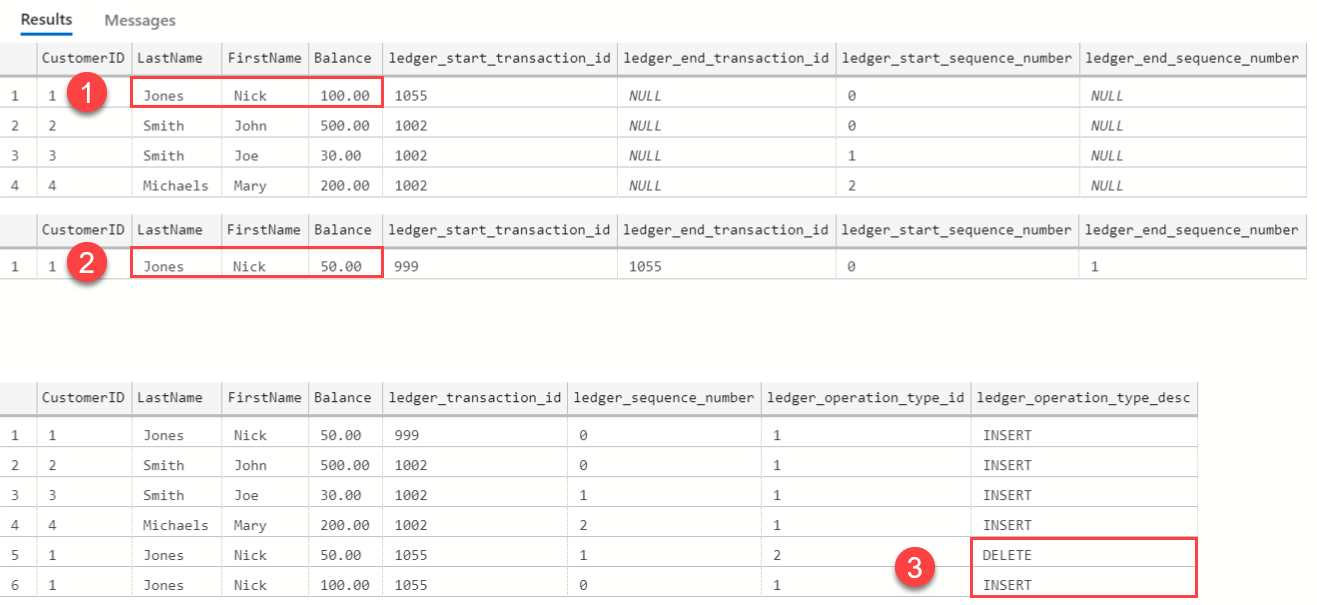Create and use updatable ledger tables
Applies to:
SQL Server 2022 (16.x)
Azure SQL Database
Azure SQL Managed Instance
This article shows you how to create an updatable ledger table. Next, you'll insert values in your updatable ledger table and then make updates to the data. Finally, you'll view the results by using the ledger view. We'll use an example of a banking application that tracks banking customers' balances in their accounts. Our example will give you a practical look at the relationship between the updatable ledger table and its corresponding history table and ledger view.
Prerequisites
Create an updatable ledger table
We'll create an account balance table with the following schema.
| Column name | Data type | Description |
|---|---|---|
| CustomerID | int | Customer ID - Primary key clustered |
| LastName | varchar (50) | Customer last name |
| FirstName | varchar (50) | Customer first name |
| Balance | decimal (10,2) | Account balance |
Use SQL Server Management Studio or Azure Data Studio to create a new schema and table called
[Account].[Balance].CREATE SCHEMA [Account]; GO CREATE TABLE [Account].[Balance] ( [CustomerID] INT NOT NULL PRIMARY KEY CLUSTERED, [LastName] VARCHAR (50) NOT NULL, [FirstName] VARCHAR (50) NOT NULL, [Balance] DECIMAL (10,2) NOT NULL ) WITH ( SYSTEM_VERSIONING = ON (HISTORY_TABLE = [Account].[BalanceHistory]), LEDGER = ON );Note
Specifying the
LEDGER = ONargument is optional if you enabled a ledger database when you created your database.When your updatable ledger table is created, the corresponding history table and ledger view are also created. Run the following T-SQL commands to see the new table and the new view.
SELECT ts.[name] + '.' + t.[name] AS [ledger_table_name] , hs.[name] + '.' + h.[name] AS [history_table_name] , vs.[name] + '.' + v.[name] AS [ledger_view_name] FROM sys.tables AS t JOIN sys.tables AS h ON (h.[object_id] = t.[history_table_id]) JOIN sys.views v ON (v.[object_id] = t.[ledger_view_id]) JOIN sys.schemas ts ON (ts.[schema_id] = t.[schema_id]) JOIN sys.schemas hs ON (hs.[schema_id] = h.[schema_id]) JOIN sys.schemas vs ON (vs.[schema_id] = v.[schema_id]) WHERE t.[name] = 'Balance';
Insert the name
Nick Jonesas a new customer with an opening balance of $50.INSERT INTO [Account].[Balance] VALUES (1, 'Jones', 'Nick', 50);Insert the names
John Smith,Joe Smith, andMary Michaelsas new customers with opening balances of $500, $30, and $200, respectively.INSERT INTO [Account].[Balance] VALUES (2, 'Smith', 'John', 500), (3, 'Smith', 'Joe', 30), (4, 'Michaels', 'Mary', 200);View the
[Account].[Balance]updatable ledger table, and specify the GENERATED ALWAYS columns added to the table.SELECT [CustomerID] ,[LastName] ,[FirstName] ,[Balance] ,[ledger_start_transaction_id] ,[ledger_end_transaction_id] ,[ledger_start_sequence_number] ,[ledger_end_sequence_number] FROM [Account].[Balance];In the results window, you'll first see the values inserted by your T-SQL commands, along with the system metadata that's used for data lineage purposes.
The
ledger_start_transaction_idcolumn notes the unique transaction ID associated with the transaction that inserted the data. BecauseJohn,Joe, andMarywere inserted by using the same transaction, they share the same transaction ID.The
ledger_start_sequence_numbercolumn notes the order by which values were inserted by the transaction.
Update
Nick's balance from50to100.UPDATE [Account].[Balance] SET [Balance] = 100 WHERE [CustomerID] = 1;View the
[Account].[Balance]ledger view, along with the transaction ledger system view to identify users that made the changes.SELECT t.[commit_time] AS [CommitTime] , t.[principal_name] AS [UserName] , l.[CustomerID] , l.[LastName] , l.[FirstName] , l.[Balance] , l.[ledger_operation_type_desc] AS Operation FROM [Account].[Balance_Ledger] l JOIN sys.database_ledger_transactions t ON t.transaction_id = l.ledger_transaction_id ORDER BY t.commit_time DESC;Tip
We recommend that you query the history of changes through the ledger view and not the history table.
Nick's account balance was successfully updated in the updatable ledger table to100.
The ledger view shows that updating the ledger table is aDELETEof the original row with50. The balance with a correspondingINSERTof a new row with100shows the new balance forNick.
Permissions
Creating updatable ledger tables requires the ENABLE LEDGER permission. For more information on permissions related to ledger tables, see Permissions.